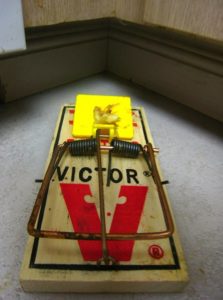Read and Learn More About Pests
Mouse Traps: History’s Most Frequently Invented DeviceMice and other rodents have been invading homes for thousands of years. The type of mouse trap that Americans are most familiar with was invented in 1897, but more than four thousand mouse trap patents have been issued by the patent office. Very few of these traps have become commercially successful, and less than two dozen have succeeded in making a profit. For many years inventors have been rushing to build a better mouse trap, and the consumer is the one who benefits from this race.
Types of Mouse Traps
Below are just a few of the most common types of mouse traps available to American homeowners. All have their pros and cons, so selecting the right mouse trap is a process of finding the best fit for your individual needs. Consider the following:
-
Spring-loaded mouse traps are the most common type of trap in the U.S. This trap was originally designed in 1897, and in 1903 it was patented. The prototype that received the patent was referred to as the ‘Little Nipper’, and the model we see today remains greatly unchanged from this original prototype.
-
Electronic mouse traps are a relatively new invention. These traps send a lethal jolt of electricity to the mouse, killing them immediately. Unlike traditional traps, these include a plastic encasing that helps to prevent accidental injury.
-
Glue traps look as simple as a normal piece of paper, but the top side of the paper features a super-sticky glue. When a rodent or other pest travels over this trap their feet become stuck and they are unable to move. Rodents tend to urinate when panicked, so these can get messy. Take care when removing glue traps and be sure to wash you rhands and the area of the floor they were set on.
-
Humane traps keep rodents from finding their way around the house without killing them. Usually these traps involve a door that is held open until the mouse finds their way inside. As soon as they enter, the door snaps shut. The pest remains inside until it is discovered by the homeowner. If using a trap like this, you should be very careful when releasing the pest. If you let it out too close to home it will usually end up finding its way right back inside.
-
Ultrasonic devices are also available, but instead of trapping or killing mice these devices claim force the pests to leave on their own. These machines emit a sound that’s too high to be heard by humans – mice are able to hear it and do not enjoy it. They are so adverse to this sound that they will scurry until they’ve found a way to escape it, which ideally means leaving your home. In order for these devices to prove effective you need one or more for each room in your house since the sound they emit can not travel through walls.
Have Traps Been Ineffective?
If you aren’t having any luck with traps it may be time to change your approach. Changing your bait can make a big difference, and so can changing the type of trap you’re using. It could be that you’re the landlord of pests that have outsmarted traps, and if that’s the case the time has come to call a licenced pest control provider.
When traps don’t work many homeowners spread rat poison throughout the home, but this can be an extremely risky decision. Your best bet for getting rid of rodents and other pests both quickly and safety is calling an experienced exterminator who is familiar with the type of pests that you’re experiencing. Do your research and find the best pest control provider for your home right away.
More Pest Control Solutions
Read Reviews
Read reviews by other customers like you.
Research
Tips and articles to help you select a pest control provider.
Find Providers
Find a qualified pest control provider in your area.


